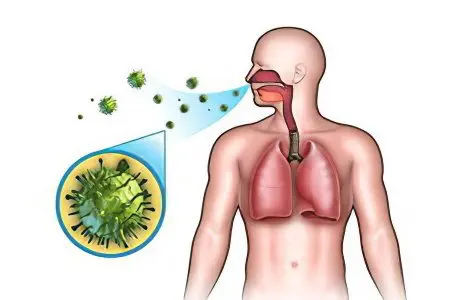Contents

Flu is an acute infectious disease of the respiratory tract caused by the influenza virus. Included in the group of acute respiratory viral infections (ARVI). Periodically spreads in the form of epidemics and pandemics.
For most people, flu symptoms resolve within a week without medical attention. But influenza can lead to severe illness and death, especially in people at risk. According to WHO estimates, annual influenza epidemics lead to 3-5 million cases of severe illness and 390-650 thousand deaths. Only in Russia every year doctors register about 27 million sick people. The recovery period is 7-15 days.
ICD-10: J10, J11
ICD-9: 487
Types of influenza virus
Type A (has subtypes A1, A2). Almost all known influenza epidemics and pandemics are caused by type A influenza virus. It has a lot of serotypes that can infect humans and animals. A variety of subtypes cause bird and swine flu. The DNA of the virus can change rapidly, so each season there are flu strains that differ from those previously known.
Type B. Influenza B viruses do not spread to the size of epidemics. They are easier to tolerate by patients, practically do not cause complications.
Type C. Cases of influenza type C are recorded quite rarely, as they have an unexpressed clinical picture or are asymptomatic.
How is the flu transmitted?

The disease develops as a result of the entry of the virus A, C or B into the body – this is the reason for the infection with the flu. The virus spreads from the source of the disease to a susceptible organism.
The incubation period ranges from 4-12 hours to 3 days.
The patient releases the maximum amount of virus in the first 6 days after infection. The higher the concentration of the virus in the excreted secret, the stronger the catarrhal phenomena (cough, runny nose, sneezing), the higher the risk of infection.
There are two ways of transmission of the influenza virus:
Airborne. The virus is shed along with saliva and sputum when an infected person sneezes, coughs, or simply engages in conversation. In the form of a fine aerosol, the virus spreads in the surrounding air and is inhaled by healthy people.
The entrance gate can be not only the mouth or nose, but also the eyes of a person. The more people in the room, the higher the risk of infection. This is especially true for close-knit teams, for example, for kindergarten groups, for classrooms, for offices, etc.
Contact-household way of transmission. It should not be ruled out that the virus can be transmitted through household contact. That is, if the sputum, which contains the virus, gets on hygiene products, on cutlery, on bed linen, and a healthy person uses these things, he will be infected.
Handshake as the cause of infection
In the course of a survey in which 1000 residents of Britain took part, it was found that 57% of them would not kiss a person who has the flu or other acute respiratory viral infections. At the same time, 86% of people would replace a kiss with a handshake.
At the same time, the myth that the flu is transmitted through a kiss with a sick person was refuted by scientists from Britain. The risk of infection increases several times if you shake hands rather than kisses.
Specialists working at Cardiff University explain this fact by the fact that the virus is transmitted through mucus, and not through saliva. That is, an infected person touches his nose, eyes, lips and mucus sticks to his hands. During a handshake, this mucus falls on the hands of a healthy person, and then in the same way is brought to healthy mucous membranes.
The results of this survey once again became evidence that the population without a medical education has little awareness of the methods of transmission of the influenza virus and SARS. Therefore, experts once again remind that close contact with the source of infection is important in terms of the spread of the virus. In this regard, coughing, sneezing and shaking hands are of particular importance.
How to distinguish the flu from colds and SARS?
Symptoms can be of varying intensity, depending on the type of influenza virus, the functioning of the human immune system, but in general, the clinical picture is determined by common signs.
| Cold | SARS | Flu |
Feeling worse | Gradual | Fast | sudden |
Body temperature | >37,5°C | >38°C | 39-40 ° С |
Intoxication | not expressed | Yes, it is expressed by increased fatigue | Have, severe chills, headache, and eye movement pain, photophobia, body aches |
Runny nose and nasal congestion | Appears at the first watch | Occurs on the first day | May appear as a complication, not earlier |

Common flu symptoms include:
Painful sensations in the muscles, aches. Muscle stiffness, aching pains in them occur as the incubation period ends and gradually increase. The culprit of muscle pain is the viral component hemagglutinin, which leads to disruption of blood circulation through the vessels. As a result, the metabolism is disturbed, the lack of oxygen increases, the natural waste products stagnate inside the muscles, causing a feeling of pain and aches.
Fever. A jump in body temperature is one of the first symptoms that the flu virus has entered the body. An increase in body temperature indicates that the body is fighting infection.
Chills, which occurs against the background of the flu, is a protective reaction of the body, which is aimed at reducing heat loss.
Loss of appetite. Appetite decreases due to the fact that the activity of the food center is inhibited in the brain. This is a feature of the human body inherent in nature, which is explained by the fact that all its forces should be directed to the fight against infection.
Cough.
The appearance of headaches.
Growing general weakness.
Complications of influenza
Keep in mind that flu symptoms only seem harmless at first, but they can have serious complications if left untreated. You definitely need to see a doctor!
Influenza can cause serious complications and consequences (up to death):
Otitis (inflammation of the ears).
Sinusitis (inflammation of the paranasal sinuses).
Meningitis (inflammation of the meninges).
Tracheitis (inflammation of the trachea).
Pneumonia, bronchitis (inflammation of the lungs, bronchi).
Myocarditis (inflammation of the heart muscle).
Glomerulonephritis (inflammation of the kidneys).
If the patient has at least 1 of the following symptoms, call a doctor immediately:
Convulsions;
Hallucinations, impaired consciousness;
Temperature above 40 C°;
Shortness of breath, difficulty breathing;
Pain in the back of the head, not relieved by drugs;
Skin rash.
Flu treatment
The following medicines are used to relieve flu symptoms:

Antiviral agents. Take antiviral drugs with proven effectiveness. These include: Tamiflu, Nomides, Relenza, Amantadine and Remantadine [1]. The choice of a specific drug and the calculation of the dosage is carried out by a specialist.
When the temperature rises above 38,5, you should take an antipyretic, for example, Paracetamol, Ibuprofen. Aspirin is contraindicated in children due to the risk of developing Reye’s syndrome!
Nimesulide preparations not only reduce the temperature, but also relieve muscle pain and headache.
For sore throat. The throat can be rinsed and treated with ready-made medicinal formulations: Chlorphyllipt, Lugol’s solution, Miramistin, Iodinol, etc. (list of throat sprays)
Cough preparations. To relieve coughing, you need to reduce the viscosity of sputum so that it is easy to cough up. Expectorants can be used to thin sputum, for example, Lazolvan, ACC, Mukaltin, Bronholitin, Bromhexine, Ambroxol, Acetylcysteine, etc. (review of cough drops)
To facilitate nasal breathing vasoconstrictor drops are used, these include such agents as: Tizin, Naphthyzin, Nafozalin, Xilen, Galazolin, Sanorin, Otrivin, Rinofluimucil, etc.
With mucosal edema. To relieve swelling with influenza, antihistamines are prescribed.
[Video] Dr. Evdokimenko – Treatment of influenza, SARS and colds: simple tips:









